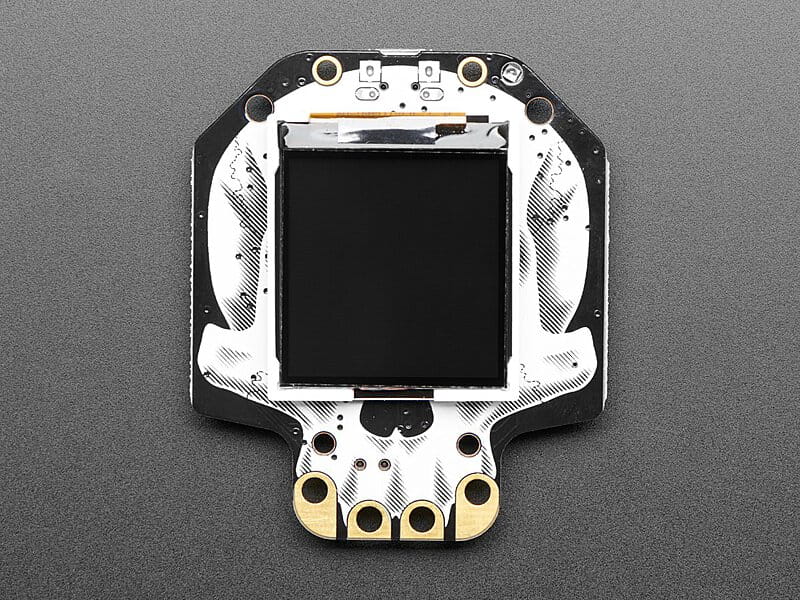
HalloWing M0 Express by Adafruit
This is Hallowing..this is Hallowing… Hallowing! Hallowing!
Are you the kind of person who doesn’t like taking down the skeletons and spiders until after January? This is development board for you. This is electronics at its most spooky! The Adafruit HalloWing is a skull-shaped ATSAMD21 board with a ton of extras built in to make for an adorable wearable, badge, development kit, or the engine for your next cosplay or prop.
On the front is a cute 1.44” sized 128x128 full color TFT. There’s also 4 fang-teeth below the display, these are analog/capacitive touch inputs with big alligator-clip holes.
On the reverse is a smorgasbord of electronic goodies:
- ATSAMD21G18 @ 48MHz with 3.3V logic/power - 256KB of FLASH + 32KB of RAM
- 8 MB of SPI Flash for storing images, sounds, animations, whatever!
- 3-axis accelerometer (motion sensor)
- Light sensor, reverse-mount so that it points out the front
- Mono Class-D speaker driver for 4-8 ohm speakers, up to 2 Watts, with mini volume pot
- LiPoly battery port with built in recharging capability
- USB port for battery charging, programming and debugging
- Two female header strips with Feather-compatible pinout so you can plug any FeatherWings in
- JST ports for Neopixels, sensor input, and I2C (you can fit I2C Grove connectors in here)
- 3.3V regulator with 500mA peak current output
- Reset button
- On-Off switch
Right now you can use the Hallowing similarly Feather M0 Express, it’s got the same chip although the pins have been rearranged. CircuitPython support, the extra 8 MB of SPI Flash is great for sound effects projects where you want to play up to 3 minutes of WAV files.
On each side of the Hallowing are JST-PH plugs for connecting external devices. The 3-pin JSTs connect to analog pins on the SAMD21, so you can use them for analog inputs. One is labeled for Neopixel and one for Sensors since most people will have one of each. The 4-pin JST connector connects to the I2C port and you can fit Grove connectors in it for additional hardware support.
Comes fully assembled and ready to be your spooky friend. Comes installed with the UF2 bootloader.
Tutorial
Purchase
Contribute
Have some info to add for this board? Edit the source for this page here.
CircuitPython 10.0.3
This is the latest stable release of CircuitPython that will work with the HalloWing M0 Express. Use this release if you are new to CircuitPython.
Modules included in this download
adafruit_bus_device adafruit_pixelbuf analogio array audiocore audioio board builtins busdisplay busio busio.SPI busio.UART codeop collections digitalio displayio epaperdisplay errno fontio fourwire i2cdisplaybus locale math microcontroller neopixel_write nvm onewireio os paralleldisplaybus pulseio pwmio rainbowio random rotaryio rtc storage struct supervisor sys terminalio time touchio usb_cdc usb_hid usb_midi warningsIncluded frozen(?) modules: adafruit_lis3dh, neopixel
Features: Display, Speaker, Feather-Compatible, Battery Charging, Solder-Free Alligator Clip
CircuitPython 10.1.0-beta.1
This is the latest development release of CircuitPython that will work with the HalloWing M0 Express.
Alpha development releases are early releases. They are unfinished, are likely to have bugs, and the features they provide may change. Beta releases may have some bugs and unfinished features, but should be suitable for many uses. A Release Candidate (rc) release is considered done and will become the next stable release, assuming no further issues are found.
Please try alpha, beta, and rc releases if you are able. Your testing is invaluable: it helps us uncover and find issues quickly.
Release Notes for 10.1.0-beta.1
Modules included in this download
adafruit_bus_device adafruit_pixelbuf analogio array audiocore audioio board builtins busdisplay busio busio.SPI busio.UART codeop collections digitalio displayio epaperdisplay errno fontio fourwire i2cdisplaybus locale math microcontroller neopixel_write nvm onewireio os paralleldisplaybus pulseio pwmio rainbowio random rotaryio rtc storage struct supervisor sys terminalio time touchio usb_cdc usb_hid usb_midi warningsIncluded frozen(?) modules: adafruit_lis3dh, neopixel
Features: Display, Speaker, Feather-Compatible, Battery Charging, Solder-Free Alligator Clip
Absolute Newest
Every time we commit new code to CircuitPython we automatically build binaries for each board and language. The binaries are stored on Amazon S3, organized by board, and then by language. These releases are even newer than the development release listed above. Try them if you want the absolute latest and are feeling daring or want to see if a problem has been fixed.
Previous Versions of CircuitPython
All previous releases of CircuitPython are available for download from Amazon S3 through the button below. For very old releases, look in the OLD/ folder for each board. Release notes for each release are available at GitHub button below.
Older releases are useful for testing if you something appears to be broken in a newer release but used to work, or if you have older code that depends on features only available in an older release. Otherwise we recommend using the latest stable release.
Update UF2 Bootloader
Latest version: v3.16.0
The bootloader allows you to load CircuitPython, MakeCode, and Arduino programs. The bootloader is not CircuitPython. You can check the current version of your bootloader by looking in the INFO_UF2.TXT file when the BOOT drive is visible (FEATHERBOOT, CPLAYBOOT, etc.).
It is not necessary to update your bootloader if it is working fine. Read the release notes on GitHub to see what has been changed. In general, we recommend you not update the bootloader unless you know there is a problem with it or a support person has asked you to try updating it.
To update, first save the contents of CIRCUITPY, just in case. Then double-click the reset button to show the BOOT drive. Drag the update-bootloader .uf2 file to the BOOT drive. Wait a few tens of seconds for the bootloader to update; the BOOT drive will reappear. After you update, check INFO_UF2.TXT to verify that the bootloader version has been updated. Then you will need to reload CircuitPython.
